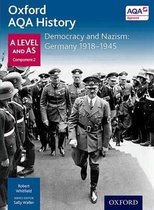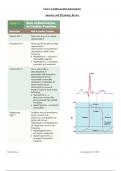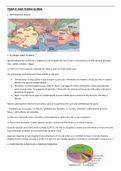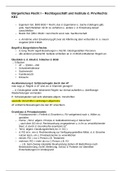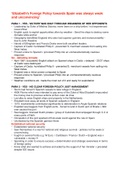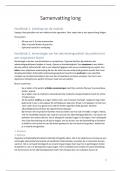THE PEACE NOTE
The civilian response:
• A shocking blow: this was the rst time that the German people had learnt about the hopeless
military situation that their country was in.
• Unpopularity of the Kaiser: it undermined the peoples respect for the Kaiser and his military
and political leaders.
• Strike at Friedrichsafen: on 22nd October had workers shouting; ‘the Kaiser is a scoundrel’
and ‘up with the German Republic’.
The military and naval response:
• Naval mutiny at Wilhelmshaven and Kiel: were cruisers refused to obey orders. It became the
beginning of a much broader revolutionary movement.
Wilsons reply and demands:
1. Germany must evacuate all occupied territory.
2. Germany must call and end to all submarine warfare.
3. Germany must fully democratic its political system.
THE OCTOBER REFORMS
Following recommendations from Ludendor , the Kaiser began a series of reforms that e ectively
ended his autocratic rule. The reforms included:
1. The appointment of Prince Max von Baden as chancellor
2. The chancellor was made responsible for the Reichstag.
3. He established a new government based on majority parties in the Reichstag, including the
SPD.
4. The armed forces were put under the control of the civil government.
• A ‘revolution from above’: these reforms were a major constitutional transformation in
Germany. The ‘revolution from above’ was designed to save humiliation from Germany as well
as save the Kaiser’s rule.
THE NOVEMBER REVOLUTION OF 1918:
1. 3rd November, unrest in the navy: spread to the navy base at Kiel.
2. 4th November, revolt spread to cities and worker and soldier councils are established
similar to the Soviets in Russia and their communist revolution!
3. 6th November, worker and soldier council revolts were all over Germany, advocating for
the abdication of the Kaiser and the establishment of a democratic republic.
4. 8th November, republic proclaimed in Bavaria and the Bavarian monarchy was deposed.
William Carr: ‘it was a decisive moment in the German revolution’.
5. 9th November, Max’s resignation, abdication of the Kaiser and Schidemann’s declaration
of a German republic all occurred on this day. Freidrich Ebert (leader of the SPD) succeeded
Prince Max. Groener told the Kaiser the army would no longer support him. Ebert proclaimed
himself as ‘imperial chancellor’ and declared his goal to bring peace.
fi ff ff
, EVENTS IN BAVARIA 1919
Context of Bavaria:
• Bavaria was one of the oldest and largest states of Imperial Germany.
• It had been a separate independent state before the German states were uni ed by Bismark in1871.
• However, even after 1871, Bavaria kept its monarchy and had special rights and privileges.
What happened in 1918?
• In 1918, King Louis III of Bavaria was deposed, and the Socialists proclaimed Bavaria to be an
independent Socialist state.
• Kurt Eisner of the USPD led the Bavarian republic.
What happened in February 1919?
• Kurt Eisner was assassinated and the Bavarian state government ed.
• The Communists declared a soviet republic in Bavaria in April 1919.
What happened in May 1919?
• The army and the Freikorps were called upon to restore order and remove the Communist threat from
Bavaria in May 1919.
• During ‘the White Terror’ hundreds of Communists were shot.
What had happened by September 1919?
• The free state of Bavaria was created within the Weimar Republic with its own minister- president,
Johannes Ho mann.
What event occurred in Bavaria 1920?
• Ho mann resigned, and the conservative Gustav Von Kahr replaced him.
• Kahr provided a safe haven in Bavaria for right-wing extremists.
EBERT’S STRUGGLE FOR POWER
Why did Ebert struggle for power?
1. Struggle to maintain law and order: his authority did not extend much further than Berlin.
2. The autocratic constitution: was embedded into the German citizens. It had been drew up
by Otto Von Bismarck 1871.
3. Lack of governmental legitimacy: Ebert was not a revolutionary, he believed in evolutionary
change through majority votes. Though being chosen as chancellor by Max, he had come to
power through a revolutionary act and was cautious that his government lacked legitimacy.
ff ff fl fi
, EBERT’S COALITION GOVERNMENT
• Ebert and Schidemann formed a provisional government composed of the SPD, USPD and ZP
who united in order to receive majority votes.
• The government maintained until national elections could be held.
• Ebert instructed Hugo Preuss to draw up a new constitution.
OPPOSITION TO EBERT
Social and economic problems:
• Rising in ation and falling wages due to the war.
• Thousands were dying from the ‘Spanish u.’
• Food and fuel shortages.
Left wing opposition:
• Fear of German communists aiming for a Revolution like that of Russia.
Right wing opposition:
• Ebert needed support from the army to deal with revolutionists but the army were conservative
and opposed the new republic.
• Growing number of Freikorps (nationalist soldiers).
Military issues:
• Peace terms still needed to be written.
• Mobilisation issue as there was still 1.5 million soldiers that needed to be brought back to
Germany.
• Allied naval blockade continued after the armistice.
THE EBERT-GROENER PACT (10/11/1918)
Context of the pact:
• Support from the army: the survival of Ebert’s government depended on the support received
from the army. However, most army o ces came from aristocratic backgrounds, retained their
loyalty for the Kaiser, and opposed democracy. They had no wish to see Germany become a
Republic.
• Political instability in Germany 1918: meant Germany faced a Bolshevik revolution, similar to
Russia’s. This would lead to a civil war and possible occupation by allied forces.
What did the pact state?
1. Groener guaranteed army support for the government.
2. Ebert agreed to oppose a Communist revolution.
3. Agreed over telephone on 10/11/1918.
Left wing reaction to the pact:
The left felt as though the pact was an object of betrayal of the revolution. This contributed to
Ebert’s struggle for power:
1. 6th December: Spartacist demonstration in Berlin was red on soldiers, killing 16.
2. 23rd/24th December: a sailors revolt against the government in Berlin was put down by the
army and 3 USPD ministers reigned.
3. 6th January: January revolution/Spartacist uprising, however was crushed after one week of
ghting in Berlin.
THE STINNES-LEGIEN AGREEMENT (15/11/1918)
What did the agreement state?
1. The trade union leader agreed that trade unions would not interfere with private ownership. In
return.
2. The leader of industrial employment agreed for an 8 hour working day and legal recognition for
worker councils.
fi fl ffi fl fi
, JANUARY 1919 ‘COMMUNIST REVOLUTION’
Timeline of events:
1. On 01/01/1919, Liebknect and Luxembourg founded the German Communist party. They
disagreed with the elections that Ebert was organising and demanded a government made up
of workers and soldiers councils.
2. On 06/01/1919, a communist committee of 53 members was set up. It proposed deposing
Ebert and establishing a revolutionary government. Armed communists occupied newspaper
o ces and public buildings in Berlin.
Was there really a revolution?
• Ebert’s government tried to negotiate with Spartacist leaders. He then asked the army for help
and Groener deployed hundreds of right wing ex-soldiers ordered into Freikrop units.
• By 15/01/1919, the communists were crushed. There was savage ghting on the streets in
Berlin. Liebknect and Luxemburg were killed.
What were the consequences of the events?
• Widespread strikes and street violence organised by the communists continued and the
Freikorps continued to deal with the violence.
• Ebert faced hostility from the far left and its sympathisers, he was accused to selling out to the
old imperial Germany.
• Ebert became increasingly reliant on the civil service and the army in order to maintain his
government.
• By mid March, over 1000 had died in the violence.
• In April 1919, Communists set up a soviet republic in Bavaria and the Freikorps were called in to
restore order.
• After savage ghting, hundreds of communists were shot.
THE ESTABLISHMENT OF THE WEIMAR CONSTITUTION 1919
STRENGTH WEAKNESS
All men and women over the At this time, Germany had N/A
age of 20 had the right to vote become the most democratic
country in Europe. Even in Britain,
only women over the age of 30
could vote.
Proportional representation Small parties in the Reichstag It made it harder for a party to
were given a chance to be gain a majority vote, which led to
represented. It was also a fair coalition governments which
system. never usually worked due to the
di erence in viewpoints.
The armed forces, civil service It was an attempt to maintain The civil service and military
and judiciary remained stability in Germany and the leaders still had enormous
unchanged government as the Republic amounts of in uence and power,
settled. which would later prove to be
crucial for appointing Hitler as
chancellor.
Electorates could decide Citizens were given a say Not everybody would use their
important issues through regarding important issues so vote.
referendums therefore the majority of people
would agree with the decision
which led to less opposition.
No state was allowed to Prevented states from being bias. There would be disagreements.
dominate the Reichsrat
ffi
ff
flfi fi

